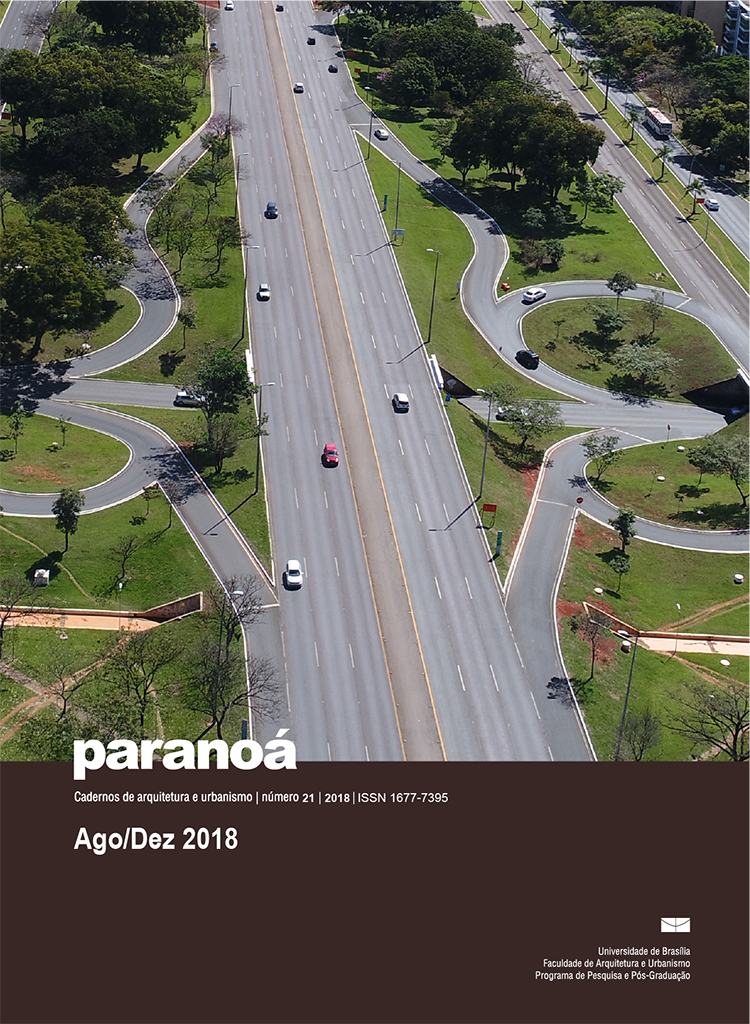Acessibilidade em edifícios de múltiplos usos mediada pela ergonomia
DOI:
https://doi.org/10.18830/issn.1679-0944.n21.2018.05Keywords:
Accessibility, Ergonomics, Mixed Use Buildings, Brazilian regulations, Social inclusionAbstract
Mixed use buildings are one of the main products of the real estate market and, as they multiply, they do not always consider the real needs of persons with reduced mobility - PRM. The present study analyzes the accessibility of two buildings in order to identify the problems arising from the inadequacies of the multifunctional buildings regarding the accessibility normative of the NBR 9050. therefore, it adds ergonomic concepts as support to evaluate if the criteria adopted since the architectural design ensured the needs and limitations of the user, as well as their comfort while moving. The method consisted of a series of steps with distinct objectives: - Analyzing the plans of the buildings and the characteristics of the PRM users; - Simulating graphically in the blueprints the circulation/obstruction possibilities; - Validating through a guided tour, identifying the difficulties and strategies of the user in the different routes. The methodology adopted has as a presupposition the analysis of the current situation and the participation of the user in the process. The results point to barriers in important accesses and even when normative standards are contemplated, comfort is not always ensured. Despite, the fragility of the data, the study proposes a reflection on the role of the normative, particularly pointing their limits.
Downloads
References
ABRAHÃO, Júlia; SZNELWAR, Laerte; SILVINO, Alexandre; SARMET, Maurício; PINHO, Diana. Introdução à Ergonomia da prática à teoria. São Paulo: Blucher, 2009.
ASSOCIAÇÃO BRASILEIRA DE NORMAS TÉCNICAS. NBR 9050: Acessibilidade a edificações, mobiliário, espaços e equipamentos urbanos. Rio de Janeiro: 2004. 105p.
”“”“”“”“”“”“ NBR 13994: Elevadores de passageiros ”“ elevadores para transporte de pessoa portadora de deficiência. Rio de Janeiro: 2000. 15p.
BÉGUIN, P. (2007a). O ergonomista, ator da concepção. Em P. Falzon (Ed.), Ergonomia (pp. 34-63). Rio de Janeiro: Y. H. Lucerna Ltda. (Trabalho original publicado em 1997).
BRASIL. Constituição (1988). Constituição da República Federativa do Brasil: promulgada em 05 de outubro de 1988. Brasília: Senado, 2006. 54p. Disponível em: www.planalto.gov.br/ccivil_03/constituicao/constituicao. Acesso em 30.06.2014
______. Legislação. Lei n°10.098, de 19 de dezembro de 2000. Estabelece normas gerais e critérios básicos para a promoção da acessibilidade das pessoas portadoras de deficiência ou com mobilidade reduzida, e dá outras providências. Disponível em: http://www.planalto.gov.br/ccivil_03/leis/l10098.htm. Acesso em 30.06.2014
______. Legislação. Decreto n°9.296, de 01 de março de 2018. Regulamenta o art. 45 da Lei nº 13.146, de 6 de julho de 2015, que institui a Lei Brasileira de Inclusão da Pessoa com Deficiência - Estatuto da Pessoa com Deficiência.
BRASIL. INSTITUTO BRASILEIRO DE GEOGRAFIA E ESTATISTICA. Censo Demográfico 2010. 2012. Disponível em <http://censo2010.ibge.gov.br/> Acesso em 13 dez 2012.
DANIELLOU, F., & Béguin, P. (2007). Metodologia da ação ergonômica: Abordagens do trabalho real. Em P. Falzon (Ed.), Ergonomia (pp. 281-301). São Paulo: Blücher. (Trabalho original publicado em 2004).
DARSES, F., & REUZEAU, F. (2007). Participação dos usuários na concepção dos sistemas e dispositivos de trabalho. Em P. Falzon (Ed.), Ergonomia (pp. 343-356). São Paulo: Blücher. (Trabalho original publicado em 2004).
FERREIRA, Luís Oscar. Mobilidade e Acessibilidade ”“ Uma Via para a Reabilitação Arquitetônica e Urbanística. Reabilita Unb, 2014.
GUÉRIN, F., Laville, A., Daniellou, F., Duraffourg, J., &Kerguelen, A. (2001). Compreender o trabalho para transformá-lo: A prática da ergonomia [Comprendreletravailpourletransformer, la pratique de l”Ÿergonomie]. (G. M. J. Ingratta, & M. Maffei, Trads.). São Paulo: Blücher. (Trabalho original publicado em 1977).
HUBAULT, F. Ergonomia e condução de projeto arquitetônico. Em Abrahão. J et all, Cadernos de TTO, n.3: trabalho, tecnologia e organização (pp.51-103). São Paulo: Blucher, 2012.
LAUTIER, F. (2007). O ergonomista nos projetos arquitetônicos. Em P. Falzon (Ed.), Ergonomia (pp. 357-369). São Paulo: Blücher. (Trabalho original publicado em 1999).
LEDOUX, E. Projetsarchitecturauxdanslesecteursanitaire et social. Du bâtimentauprojet: lacontributiondesergonomes à l’instructiondeschoix. Bordeaux: Université Victor-Segalen, 2000.
Downloads
Published
How to Cite
Issue
Section
License
Autores que publicam nesta revista concordam com os seguintes termos:
- Autores mantém os direitos autorais e concedem à revista o direito de primeira publicação, com o trabalho simultaneamente licenciado sob a Licença Creative Commons Attribution que permite o compartilhamento do trabalho com reconhecimento da autoria e publicação inicial nesta revista. http://creativecommons.org/licenses/by/4.0
- Autores têm autorização para assumir contratos adicionais separadamente, para distribuição não-exclusiva da versão do trabalho publicada nesta revista (ex.: publicar em repositório institucional ou como capítulo de livro), com reconhecimento de autoria e publicação inicial nesta revista.
- Autores têm permissão e são estimulados a publicar e distribuir seu trabalho online (ex.: em repositórios institucionais ou na sua página pessoal) a qualquer ponto antes ou durante o processo editorial, já que isso pode gerar alterações produtivas, bem como aumentar o impacto e a citação do trabalho publicado (Veja O Efeito do Acesso Livre).















